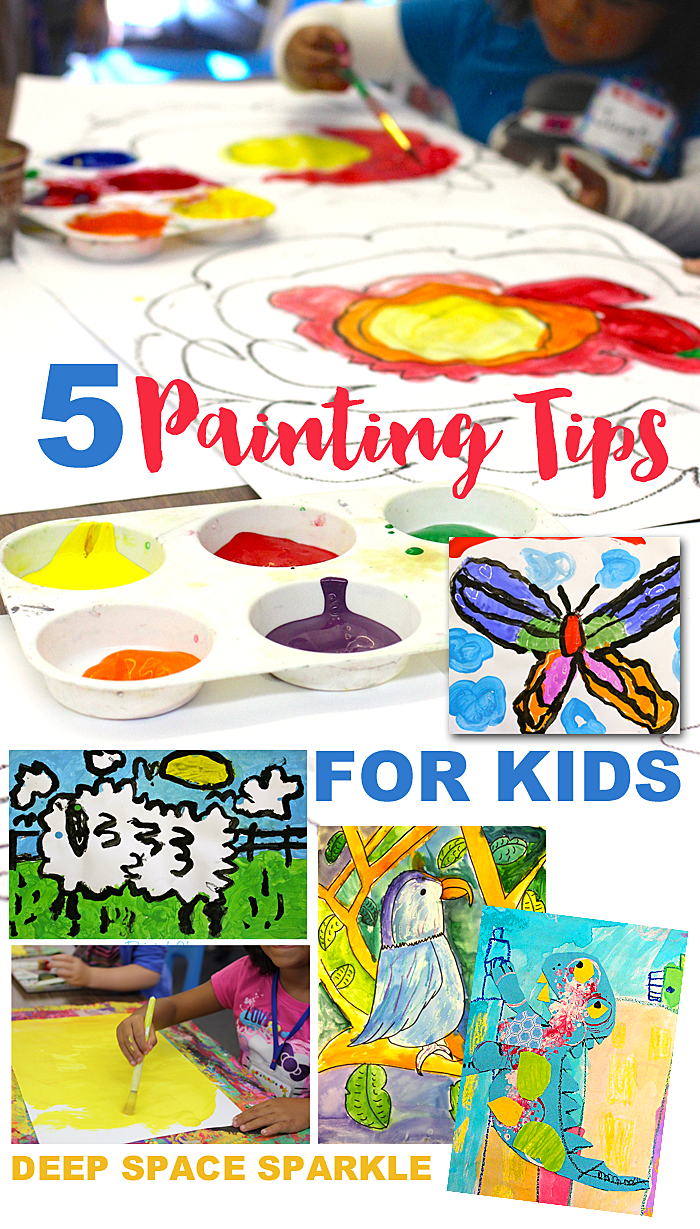
5 Tips for Painting with Kids
You’ve all seen the amazing art projects on art teacher blogs and Pinterest. Inspiration and ideas are everywhere. But you may be wondering if you can achieve the same results with your kids. You have questions: Does paper matter? What about paint? As an art teacher for over 13 years, I’ve tried a lot of techniques with my students and have come up with my top 5 tips painting tips for kids.
Download our free management, set-up, drawing & painting guide, to help you teach art from your home!
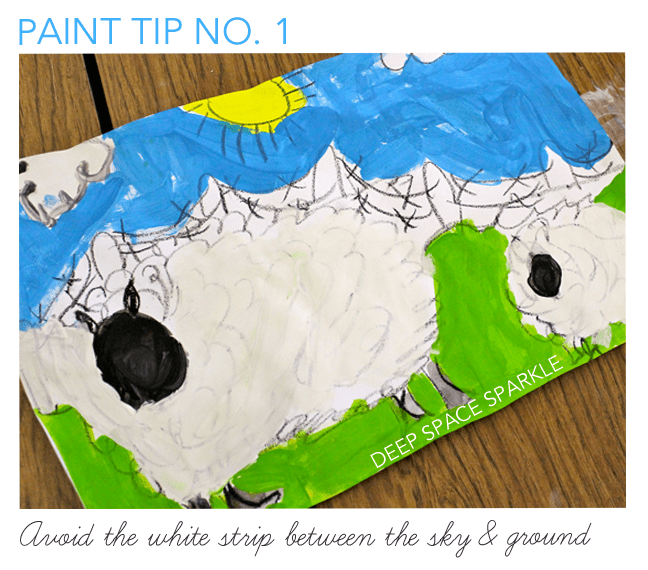
UNDERSTAND HORIZON LINE
Many art projects for kids involve a horizon line. It seems like a big word for little kids but many kids feel that there is a big, white strip between the earth and sky. You know what I mean. Kids instinctively feel that the blue sky belongs up there. To remedy this, it’s surprisingly easy to teach the kids how to draw a horizon line.
This is what I say: The horizon line separates the earth/ocean from the sky. Everything above the line is the sky and everything below the line is the ocean. That’s it. They all get it.
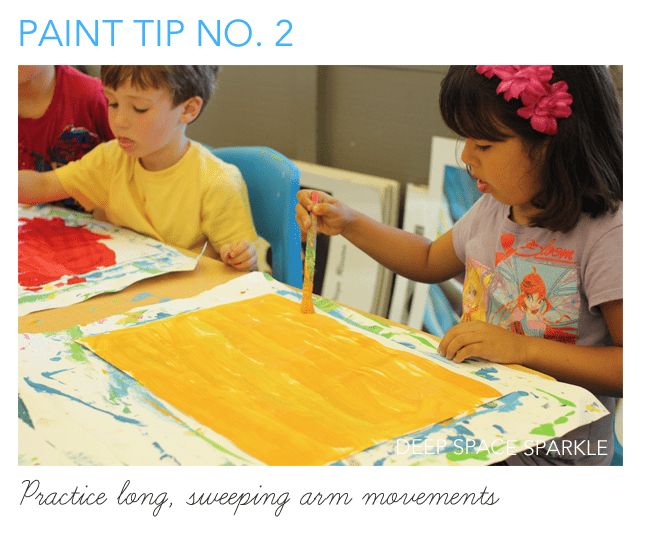
BIG STROKES THAT GET THE TABLE MESSY
Many children are very tentative when it comes to painting. This often translates to painting with small, careful strokes. Maybe they are worried that the table will get messy. Maybe not. I like to start my Kinders with a big, free-expression paint project on the very first day of art class. Creating painted papers is my favorite as they can get messy, use lots of paint and get lots of practice. The process proves that there is no wrong way to paint, that art class is fun and that it’s okay to paint off the paper.
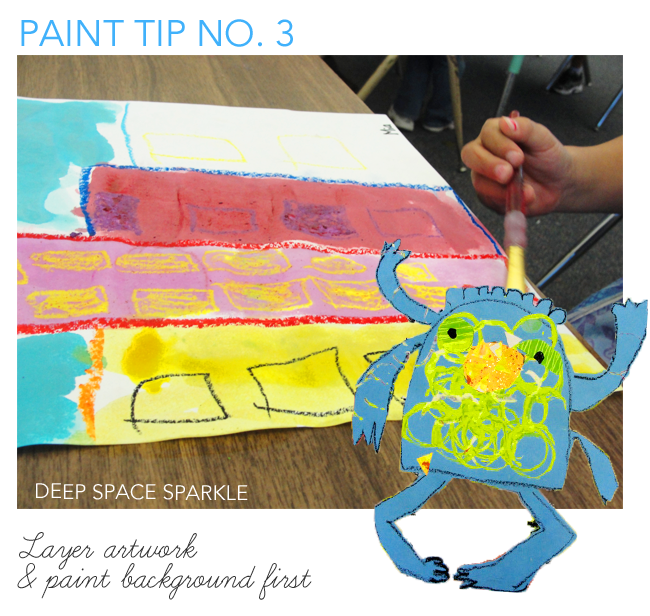
LAYER ARTWORK
When creating a piece of art with many layers: background plus a subject, it can sometimes be easier to separate the layers. In this project, Monsters Don’t Eat Broccoli, the art project involved drawing a city/skyscarpers and a monster. The obvious step would be to draw a monster and then draw the city behind the monster. Instead, I broke up the layers and created TWO projects then combined the two.
Using a big sheet of paper to draw the city gave the children lots of wiggle room to paint. This allows them to paint more freely without worrying whether the skyscraper paint would go over the monster. The result is a sharper, less muddled art.
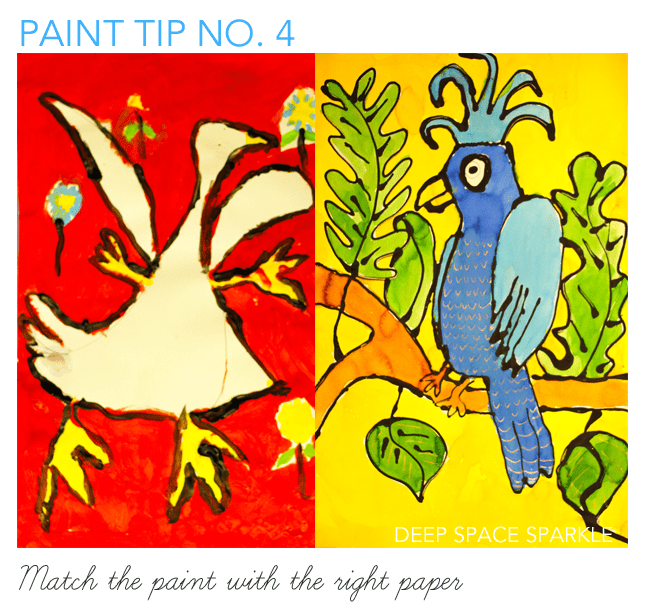
PAPER & PAINT
This may seem obvious but it’s the question I get asked the most often: What paper did you use?
I totally get this as I had the exact same question when I first started teaching. Once you have experimented enough, you know what paper brings out the best features in paints.
Here’s the trick: use school-grade, 90 lb watercolor paper for watercolor paints only. Don’t waste your expensive watercolor paints on acrylics or tempera. They can go on almost any other kind of paper.
The photo onto right is liquid watercolor paint on watercolor paper.
For tempera paint, use sulphite paper. This is also called drawing paper. It will curl a bit when using wet paint (so what? Flatten with a few books after the artwork dries).
The photo on the left is liquid tempera paint on white sulphite paper
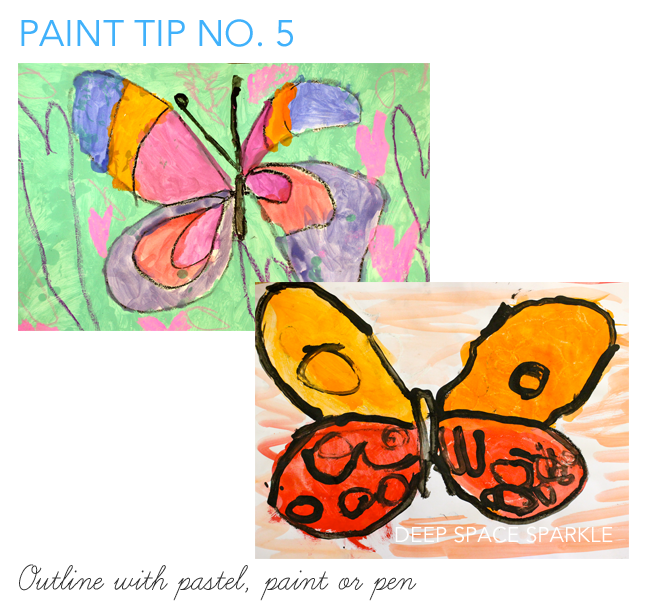
OUTLINE OUTLINE OUTLINE
Kids are messy painters. To sharpen up their amazing pieces of art, one of the tricks I use is to outline the main drawing lines. You can use whatever medium suits the project: oil pastel, black marker, black paint, crayon. And it doesn’t have to be black. The important thing is to define the details of the subject. This one small step can really make the difference.
Download our free management, set-up, drawing & painting guide, to help you teach art from your home!












The paper and outlining are so important! The main thing for me is to patiently teach them correct technique. Some art teachers feel like you should just let them loose as not to stifle their innate creativity, but teaching the proper way to use materials (and the brush strokes) is super important too. It makes them more confident to be even more creative!
Awesome tips thank you!! I’ve found you have to teach them how to hold a brush and clean it properly. With my younger students we paint with one colour at a time (allowing it to dry) and practise painting before we build up to using more than one colour.
Can someone from deep space sparkle email me. I have a few questions about the classes. Thank you
Hi there,
Go ahead and ask us any questions. You can contact us through our contact page. Go to menu bar and click/scroll contact us. Thanks!
Can you explain why you premix the paint for this project rather than have students learn to mix colors. Any tips you have for teaching kinder and 1st graders to mix colors with tempera would be appreciated!
Sorry – was referring specifically to the painted pears project. Thank you!
I don’t find it necessary for children to mix colors with every project. Sometimes, baby steps are best. Here’s some lessons that teach color mixing/theory: https://www.deepspacesparkle.com/color-theory/
I noticed you use cake tempra paints. What brand do you recommend? I am a fan of acrylic myself. It dries with a glossy finish and the colors are more vibrant. But in the kinder video you have when you are painting fish, your tempra paints seemed to work well!! I thought I would give them a try. But there are so many brands out there. I would love one that dries nicely, doesn’t crack and isn’t chalky. Thanks so much for your help. We are doing Jackson Pollock’s today with acrylic in TK! Wish me luck
It’s really hard to get the same acrylic finish with tempera but many products come close. Acrylic paints in my mind, are very difficult to use in the art room with little ones (stains clothes, clogs sink, etc) so I love tempera as it is far more age appropriate than acrylic.
The brand of cake tempera I use is Richeson from Blick. But it dries to a chalky finish. It still looks lovely though. Faber-Castell makes a better opaque watercolor that acts like cake tempera.
Let me know what you chose and how it works.
Here’s a list of the PDF of products I like: https://www.deepspacesparkle.com/shop/art-supplies-for-the-art-room/
You feel it’s ok to outline the artwork for them?
I think it’s best for the children to outline their own art work. This allows them the opportunity to add detail and personal expression. I think the way I wrote this tip may be confusing…but it’s the kids who are doing the outlining, not me. 🙂
With little to no times between Looking for Suggestion for “passing out paint” and not wasting so much of it?
Your methods seem sound, supportive, and versatile–much better than the quickie craft project approach designed for parents fearful their kids will be bored or likewise intimidated.
Under “Paint and paper” paragraph you say:
Here’s the trick: use school-grade, 90 lb watercolor paper for watercolor paints only. Don’t waste your expensive watercolor paints on acrylics or tempera. They can go on almost any other kind of paper.
Did you mean to put “don’t waste watercolor paper” instead?
Amazing Tips!!! Thanks Patty:)